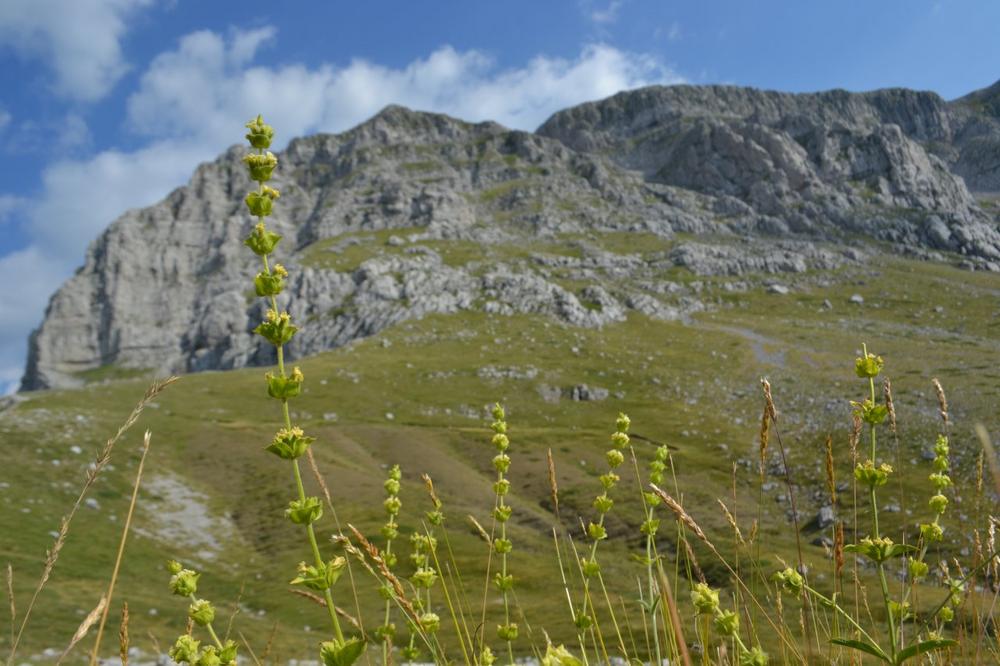Visible from Space: Loss of Genetic Plant Diversity

Breaking News:
Dienstag, Dez. 23, 2025

Mountain regions are hotspots of biodiversity and represent some of the most species-rich habitats overall. However, these diverse ecosystems are being rapidly transformed by global change. Over the past five decades, rising temperatures and changes in land use at high altitudes have encouraged the growth and spread of highly competitive plants such as shrubs and trees – a process known as “mountain greening.” The specialized and often lowgrowing species of open grassland habitats are being pushed back as a result. Sideritis, a characteristic and important plant of the montane grassland flora in the Mediterranean region, is also affected by this development. The herb, also known as Greek mountain tea, comprises several closely related species and is used by the local population and the pharmaceutical industry due to its healing properties for coughs, colds, and gastrointestinal complaints. At the same time, the popular medicinal plant is an indicator of the health of open mountain habitats.
As part of the recently published study, the research team investigated the effects of increasing greening on the genetic diversity of Sideritis, using an innovative methodological approach. “We examined populations in eleven Greek mountain ranges and combined satellite data from several decades with genetic analyses of herbarium specimens from the 1970s and present-day plant samples,” explains study leader Dr. Spyros Theodoridis, a former research associate at the Senckenberg Biodiversity and Climate Research Center in Frankfurt, who now works at the National Observatory of Athens. “The results show that in eight of the eleven mountain regions we studied, genetic diversity declined significantly during this period. In particularly affected regions, up to 20 percent of the genome of individual plants is now subject to inbreeding – an indication of declining population sizes.”
“The speed at which shrubs and trees are spreading in previously open grasslands can be directly linked to the decline in genetic diversity in Sideritis populations,” adds co-author Prof. David Nogués-Bravo from the University of Copenhagen. “The genetic diversity of a species is crucial for its ability to adapt to environmental changes. If this diversity dwindles, resistance to disease, drought, or other stress factors decreases, which can lead to extinction in the long term.”
A special aspect of the study is that it combines two entirely different data sources – remote sensing by satellite and genomic analyses – thus allowing conclusions to be drawn about the development of plant populations over several decades. “This combination opens up new possibilities for biodiversity monitoring,” emphasizes Theodoridis. “It allows us to use satellite images to identify indications of genetic changes in mountain ecosystems without having to genetically examine each individual population on site.”
Monitoring the loss of genetic diversity from space was previously considered impossible. “However, our results show that the extent of genetic erosion can be predicted with surprisingly high accuracy based solely on the increase in vegetation density,” adds co-author Prof. Dr. Thomas Hickler from the Senckenberg Biodiversity and Climate Research Center in Frankfurt. "This renders our method particularly attractive for use in mountainous regions that are difficult to access or in areas where genetic monitoring has hardly been possible to date.”
The study also underlines the importance of natural history collections. “Without the historical plant specimens in herbaria, the direct comparison over a period of 50 years would not have been possible,” emphasizes co-author Prof. Dr. Marco Thines, also from the Senckenberg Biodiversity and Climate Research Center. “These archives of nature are invaluable for biodiversity research.“
The increasing greening of mountain regions due to global warming and the abandonment of traditional forms of cultivation is widespread around the world and is clearly evident from satellite images. The researchers therefore recommend that conservation measures should be prioritized in areas that are most severely affected by mountain greening. “There is also an urgent need for comparable studies with other species and in other regions,” concludes Theodoridis. “This will allow us to gain a comprehensive picture of how environmental changes are affecting the genetic basis of biodiversity – and how we can effectively counter this development.”
The Senckenberg Gesellschaft für Naturforschung (Senckenberg Nature Society), a member institution of the Leibniz Association, has studied the “Earth System” on a global scale for over 200 years – in the past, in the present, and with predictions for the future. We conduct integrative “geobiodiversity research” with the goal of understanding nature with its infinite diversity, so we can preserve it for future generations and use it in a sustainable fashion. In addition, Senckenberg presents its research results in a variety of ways, first and foremost in its three natural history museums in Frankfurt, Görlitz, and Dresden. The Senckenberg natural history museums are places of learning and wonder and serve as open platforms for a democratic dialogue – inclusive, participative, and international. For additional information, visit www.senckenberg.de.
Senckenberg – Leibniz Institution for Biodiversity and Earth System Research // Senckenberg Gesellschaft für Naturforschung
Senckenberganlage 25
60325 Frankfurt
Telefon: +49 (69) 7542-0
Telefax: +49 (69) 746238
http://www.senckenberg.de
![]()